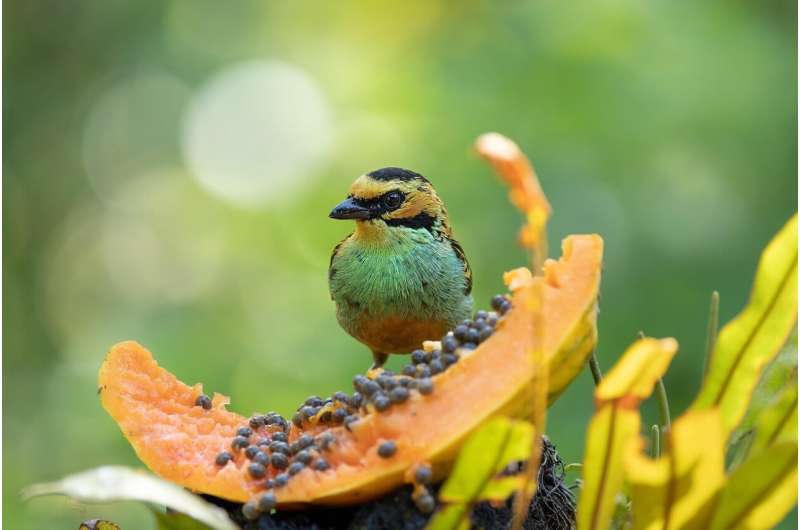Science
Research Reveals How Birds Use Hidden Feathers to Enhance Colors

Birds have long been celebrated for their vibrant colors, but new research from Princeton University uncovers a fascinating mechanism that enhances these hues. A study published in Science Advances on July 26, 2025, led by researcher Rosalyn M. Price-Waldman, reveals that certain birds utilize hidden black and white feathers to amplify their plumage’s vibrancy.
This innovative approach involves layering colored feathers over either black or white underlying feathers, which significantly alters how light interacts with the colors. The research highlights that male birds, often more colorful than their female counterparts, benefit from this technique to attract mates. The study’s findings indicate that the differences in coloration between males and females may not solely be due to the pigments in their feathers but rather the amount of black or white underneath.
Enhancing Brightness Through Layering
The process relies on the principles of sexual selection, a concept first articulated by Charles Darwin. Males with more vivid colors are likely to attract mates, thereby increasing their reproductive success. By placing a black layer beneath bright blue feathers, males can create a striking contrast that enhances the perception of color. The black layer absorbs light that passes through the top feathers, allowing only the blue wavelengths to reflect, resulting in a more intense hue.
In contrast, the study found that yellow feathers, which contain carotenoid pigments, become brighter when layered over a white under-layer. This white layer reflects light that enhances the brightness of the yellow, making these patches stand out even more.
A Widespread Adaptation in Birds
The researchers primarily focused on tanagers, a group of colorful fruit-eating birds native to Central and South America. Their findings prompted an investigation into other bird families, revealing that this clever use of underlying feathers is prevalent among various species, including the Australian fairy wrens, known for their vivid blue plumage.
The implications of this research extend beyond avian beauty. Understanding how birds have developed such intricate signaling mechanisms could influence color production in fields like architecture, art, and fashion. The findings suggest that this method of enhancing color has been utilized by birds for tens of millions of years, highlighting an evolutionary strategy that spans diverse species.
The study not only enriches the understanding of bird coloration but also opens avenues for exploring how complex traits evolve in nature. As researchers continue to uncover the secrets of avian beauty, the interplay between biology and aesthetics may yield insights applicable to human creativity and design.
For further details, refer to the study by Rosalyn M. Price-Waldman et al in Science Advances, DOI: 10.1126/sciadv.adw5857.
-

 Technology5 months ago
Technology5 months agoDiscover the Top 10 Calorie Counting Apps of 2025
-

 Health2 months ago
Health2 months agoBella Hadid Shares Health Update After Treatment for Lyme Disease
-

 Health3 months ago
Health3 months agoErin Bates Shares Recovery Update Following Sepsis Complications
-

 Technology4 months ago
Technology4 months agoDiscover How to Reverse Image Search Using ChatGPT Effortlessly
-

 Technology1 month ago
Technology1 month agoDiscover 2025’s Top GPUs for Exceptional 4K Gaming Performance
-

 Technology2 months ago
Technology2 months agoElectric Moto Influencer Surronster Arrested in Tijuana
-

 Technology5 months ago
Technology5 months agoMeta Initiates $60B AI Data Center Expansion, Starting in Ohio
-

 Technology5 months ago
Technology5 months agoRecovering a Suspended TikTok Account: A Step-by-Step Guide
-

 Health4 months ago
Health4 months agoTested: Rab Firewall Mountain Jacket Survives Harsh Conditions
-

 Lifestyle5 months ago
Lifestyle5 months agoBelton Family Reunites After Daughter Survives Hill Country Floods
-

 Technology4 months ago
Technology4 months agoHarmonic Launches AI Chatbot App to Transform Mathematical Reasoning
-

 Technology3 months ago
Technology3 months agoUncovering the Top Five Most Challenging Motorcycles to Ride





















